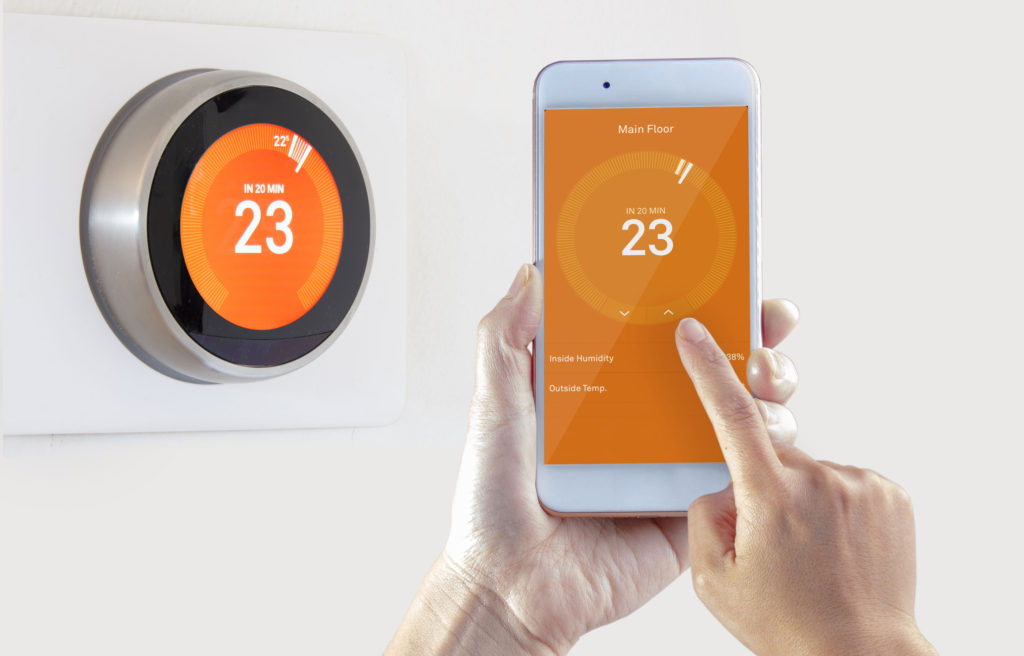
Everybody knows how annoying it can get when you set up the right mood and take a seat. You realize you forgot to set the right room temperature, then you need to get up again to set the right room temperature.
Well, worry no more! Having a smart thermostat will end these and similar problems. Let’s be honest, sometimes getting up from a comfortable position just to do such a small but meaningful task can totally be a mood killer.
Luckily, smart thermostats were practically invented for situations like these.
How To Set Up A Smart Thermostat In A Few Easy-To-Follow Steps
Before purchasing a smart thermostat, make sure that the model you choose is compatible with your HVAC system and wiring. If not compatible, this can cause you several complications for which you will need professional assistance.
If you are unsure about the compatibility, you should definitely seek professional help.
Turn OFF Power Source
Before you start the process of setting a new thermostat, you should obviously take down the old one first. You should start by turning off the power of your existing thermostat. You will find a turn-off switch at the circuit breaker.
Making sure your entire HVAC system is without power is a huge security measure. HVAC is short for heating, ventilation, and air conditioning. The HVAC system is responsible for controlling all three of these processes.
Having no power delivered to the thermostat while swapping out the old thermostat with the new one, will make sure no short circuit happens. This is a common issue when working with wires. This is also often a dangerous task and the only valid and safe prevention is turning off the entire power flow. A short circuit happens when two or more components make an unintended contact. This contact results in accidental diversion of the current. The problem is that a very high current is flowing through the circuit meaning the circuit was not made for such high current. A short circuit can damage or totally destroy your component, which can sometimes cause a fire. On another note, a short circuit of high current can greatly jeopardize your health. So it is way easier to just simply turn off the current flow and protect yourself from disastrous accidents.
Don’t worry but inform yourself well before you do anything yourself. Once you have thermostat power turned off, you can move on to the next step.
Removing The Old Thermostat
This part is something that cannot be skipped and everyone is well aware of this. After all, we decide to buy something new because we want to replace something that is outdated and old.
Thermostats are pretty much all the same if we speak about their components. For now, you should focus only on faceplate and baseplate. Start off by taking off the faceplate. After doing so, you will clearly see the already existing wires.
At this point don’t touch anything before you do something that can save you tons of nerves and sweat. Pick up your phone or any camera and take photos. Yes, you read that right! You might be asking why is this important?
Let’s see.
By taking photos of the older thermostat wiring, you will have it stored away and waiting to be used if needed. Not only will you have a reminder of how wires were connected before detaching, but this will also come in handy if, for any reason, the set-up of the new thermostat goes wrong. This way you will be able to reconnect the old thermostat without breaking too much sweat.
Another perk of these wire snaps is if you need to reach out to the electrician and they ask about the previous wiring setup. You can just show them photos and save yourselves from any questions and complications .
Having taken off the entire previous thermostat, meaning faceplate, detaching wires, and base plate, you can move on to installing your new shiny smart thermostat
Installation of The Baseplate
After you checked the compatibility between your HVAC system and the new smart thermostat, you can proceed with the process of the installation.
First off you will need a screwdriver. By finding the appropriate screwdriver you will be able to install the thermostat faceplate onto the wall. When purchasing a smart thermostat you should check if it comes with the necessary screws or you’ll be needing another stop at the corresponding shop. However, it is highly unlikely that the thermostat is being sold without the corresponding screws.
On a side note, sometimes the existing screw holes on the wall from the previous thermostat won’t be appropriate for the new one. This is a common issue if you decided to buy a smaller or bigger thermostat or a thermostat of an entirely different shape. In this case, you might need a drill for small holes that will hold your screws. If you find yourself in this situation pay attention to the wires that are inside the wall. This should not cause you any additional problems since these holes shouldn’t be huge, thus the drilling won’t be deep into the wall.
Proceed with screwing the baseplate onto the wall. When finished with attaching the baseplate to the wall, you can continue to the next step.
Wires & Wiring System
Here comes the most important part of the thermostat installation. This is the part where you need to be focused and entirely concentrated on what you are doing.
As previously mentioned – not turning off the current flow can lead to a short circuit and a lot of damage, so make sure this step is already done. The correct setting of the wires is crucial since the power courses through them and therefore provides power to your thermostat.
Types of wires. You will be seeing the same letter symbols for each wire since their label is a worldwide standard. Those letters are R, Y, W, G, and C. Each and every one of these wires have their respective roles in the current flow. In more simple words, each wire brings power to the specific part of the thermostat. This way the thermostat can receive your commands and deliver them through controlling each wire separately.
To understand this better you should probably learn which wire controls which part and what is the letter label of that wire.
It’s also good to know the common voltage of the smart thermostat. Most of them are 24VAC. These are considered as low voltage thermostats. There are also line voltage systems that are usually 120VAC or 240VAC. Low voltage thermostat won’t work with the line voltage system and vice versa. The voltage is usually labeled somewhere inside the thermostat and you should be able to see it after you take off the faceplate of the thermostat. If you are by any chance unsure, you should definitely seek professional help.
Wires used in a Smart Thermostat
- R wire – this one basically means 24VAC power. This is a wire that enforces pure and general power from the furnace transformer.
- Y wire – this wire signals to turn on the cooling
- W wire – signals turning on the heating
- G wire – signals to turn on the fan
- C wire – 24VAC; often referred to as ‘common’ wire.
C Wire Explained in Detail
This wire is somewhat optional. Some thermostats require its existence, while the others work perfectly without it.
This wire’s job is basically to ensure that there is continuous power from the R wire to the furnace transformer. The R wire cannot complete the continuous power flow by itself, so this common wire helps it.
Older, ‘not smart’ thermostats didn’t require this C wire. However, some installations already have this wire installed, probably as a backup wire for the back-in-the-day type of issues. This wire will either be tucked into the terminal labeled ‘C’, if it existed on your previous thermostat. Otherwise, if it wasn’t being used or the older thermostat didn’t have the C-terminal, this wire might be tucked away somewhere near the other wires. If not immediately visible, this wire might be right behind the wall.
What if you don’t have a C wire? Should you add it to the wire bundle and how will you do it? Are there any options?
Stick with us till’ the end to find out!
As previously mentioned the C wire ensures continuous power flow from the furnace transformer. This is important for smart thermostats because they use more power than the older versions. More power is used because of all the Wi-Fi power requirements.
While the other thermostats needed power only for information delivery as in ‘turn on’ and ‘turn off’ or similar, smart thermostats use the power almost constantly.
Almost every smart thermostat needs a C wire. However, there are still some that don’t require it. These thermostats also need a constant source of power but when they use all the storage power, they will pull little power elsewhere from time to time. This basically means it turns on, then quickly off the furnace transformer. Having a C wire regulates this by generating a constant source without any extra pulling.
Now that we have established what’s the C wire needed for, we understand its importance.
Having a C wire installed for the previous thermostat will make the whole setup process a lot easier. However, not having it will require extra work.
No worries though! We are here to help you. You have several options to choose from.
At this point, you can either purchase a smart thermostat that doesn’t require a C wire or redo all the wiring system and install a C wire.
You should definitely consider installing a C wire if you don’t have one. This is purely for the reason that most smart thermostats need and use the C wire. This is something that will not be, by the looks of it, changing any time soon.
When you think about it, a C wire is actually of great help. If at any point you don’t feel like you can safely carry out the entire installation process, please don’t refrain from calling professional help. After all, you pay them to do this job for you without breaking any sweat.
After you checked or installed all the wires, you can proceed to pluck them into their terminals that are labeled with the letter they carry.
When you are done doing this, you can move on to the next step.
Installing the Faceplate
At this point, everything should be set as far as setting up the wiring.
Now it is time to place the faceplate over the wired baseplate. Before placing the faceplate, you should definitely take one last peek at the wiring and check if you have put all the wires in their corresponding terminals.
After you secured the faceplate without any issues, you can finally turn on the HVAC system again.
After providing power flow to your new smart thermostat, you will see it boot up similar to a phone or laptop. This is probably the part where you become aware that you have successfully installed a smart thermostat. You can finally continue to the fun smart part of the installation.
Connection
Since this is a smart gadget, a Wi-Fi connection is required. The next steps depend on each smart thermostat manufacturer. It is a basic setup procedure, but you need to pay attention to the required information. After you have set up the connection, there is only one step left until you are done and ready to use your smart thermostat.
App
A smart thermostat comes with a corresponding application. You generally have the choice of downloading the app to your smartphone, desktop or both. Syncing all your devices will make everything extremely convenient!
Different smart thermostat manufacturers use different applications, but you will find all the necessary information in the product guide after you purchase the product.
Following quick and easy steps, you’ll connect to the app and will be able to control the smart thermostat through a Wi-Fi connection.
Why Should You Use A Smart Thermostat?
The difference between the old thermostats and smart thermostats is huge.
Using an old thermostat didn’t provide as many options for the user as the smart ones provide.
The biggest difference is actually the possibility to control it without coming close to it. With the old thermostats, you need to approach it and actually press the buttons for each function you want performed. However, having a smart thermostat, you can easily change the temperature while being nowhere near the thermostat.
The possibility to turn off the heating or turn on the cooling, before you come home is life-changing.
Now, it may have sounded as if smart thermostats use more power than the old ones, therefore they cost you more money when your electric bill arrives, but the costs even out. Before you had to leave the heating on, so the room stays warm for when you arrive, meaning, your heating system had been running all day. With the smart thermostat, you can literally set a timer for when you need heating or cooling to start. Also, you can do it from wherever you are, not having to think about a timer in advance or calculating when you are coming back home.
Another huge perk of the smart thermostat is its integrated voice command system. You can perform your commands vocally and the thermostat will do as you said. This is done through voice platforms such as Siri, Alexa, Google Assistant or similar. Checkout this extensive guide on the Best Smart Device to pair with your smart thermostat.
Installation of the smart thermostat is easy and you can do it just by following our easy and elaborated steps.
What to pay attention to and what should you avoid?
When installing a new thermostat, you should pay attention to the size. If there is some kind of mismatching happening, you should realize you will need a little bit of wall paint or wallpaper fixing. However, don’t worry, many smart thermostat manufacturers came up with the idea of making a small ‘cover-up’ platform. This is often a small piece of plastic that will cover the wall issue.
Another thing to pay attention to is the time of the thermostat exchange. You should avoid doing this replacement if there is a huge thunderstorm coming or if the weather is too hot/ cold and you will be needing the HVAC system functional. Not to make you doubt yourself, but always be self-conscious and leave some space for potential mistakes. Everybody makes mistakes and this is okay only while you pay attention not to do the ‘big no-nos’.
You should know that you might need some tools for making your wires more attachable to the new thermostat. This often referrers to small pincers made for cutting or trimming wires. This is not something that everyone knows how to do, so if you are in need of such a task, but you haven’t done it before, you should consider contacting somebody that is used to or professional personnel.
If at any point you don’t feel like you can proceed safely or you simply don’t know what to do, please seek professional help.
Our Recommended Smart Thermostat: The Ecobee3
Conclusion
Smart thermostats are surely a smart choice. Not only they bring so many new abilities to the users, but they are easy to use.
We have elaborated each and every step and if you decide to follow them, they can help you install your smart thermostat in a blink of an eye.
Quick step reminder:
- Turn off thermostat power flow
- Take off the faceplate of the existing thermostat
- Take a good look at the wiring and snap a clear photo
- Detach wires and take off the old baseplate
- Check the wires and install a C wire
- Set up a new baseplate
- Connect all the wires to their corresponding terminals
- Put on a faceplate
- Turn on the power flow
- Boot up the system
- Connect to the Wi-Fi
- Sync with the corresponding app
Don’t forget to follow all the steps and to seek help if needed.
Have you tried installing a smart thermostat by yourself? Did our step-to-step guide help you in the process? Leave us a comment, we would like to hear from you!



